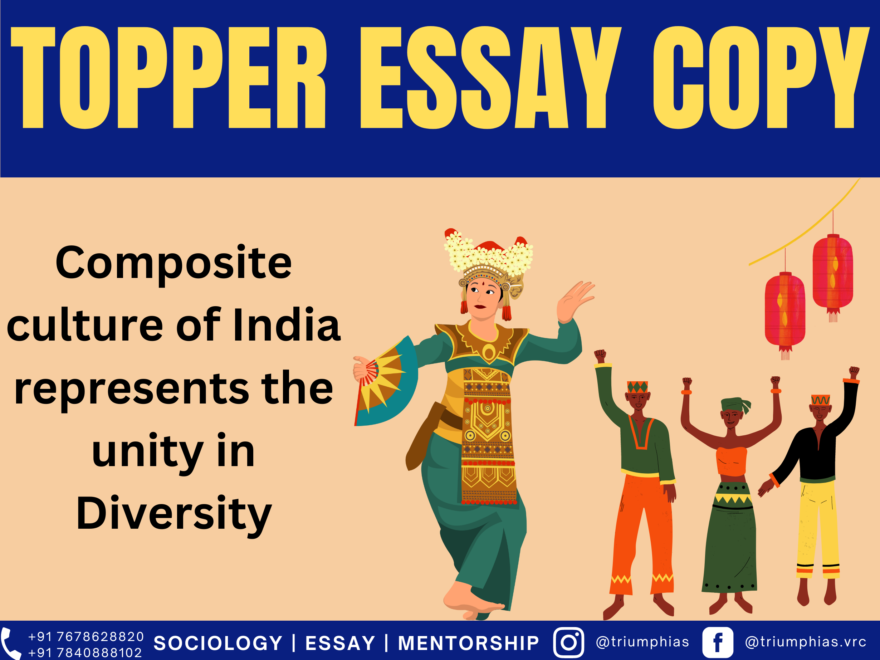
IAS, ANUP GARG took Mentorship under the
Personal Guidance of “Vikash Ranjan Sir”

Essay Topic:
Composite culture of India represents the unity in Diversity
(Relevant for Essay Writing for UPSC Civil Services Examination)
Composite culture of India represents the unity in DiversityGurudev Rabindranath Tagore’s composition of India’s National Anthem, ‘Jana Gana Mana’, creatively represents India’s composite culture, showcasing the unity in diversity. It includes references to various regions of India, symbolizing the idea of “INDIANNESS”. This reflects the true spirit of India’s unity amidst its diverse cultural heritage. India’s rich history as the cradle of civilization encompasses both internal and external dimensions. Internally, the presence of ancient civilizations like the Harappan, Mauryan, and Gupta empires strengthened the idea of a unified India. Externally, various groups such as the Aryans, Greeks, Kushans, Turks, and Mughals contributed to India’s composite culture by adopting it as their homeland and making significant contributions. While threats like homogenization, secessionism, and jingoism exist, history has shown that the idea of “INDIA” always surpasses these forces. The sun will rise again, symbolizing the resilience and brightness of a new India. India’s unity in diversity is also reflected in its culture, which forms a robust foundation for the country. Religion plays a primary role in Indian society, with India being a multi-religious nation. Festivals like Holi, Diwali, Lohri, and Eid are celebrated by people of different religions, fostering a sense of unity among citizens. Secular festivals like Bihu and Pongal highlight the diversity of India. Tribal festivals, such as Adi Mahotsav, showcase the unity amidst diversity. Dance and music are integral parts of Indian culture. From classical dance forms to contemporary styles, Indian dance is diverse and beautiful. Music has evolved from Hindustani and Carnatic classical traditions to newer forms like rock and pop. The multitude of languages, traditional dresses, and delicious cuisines further exemplify India’s diversity. India’s cultural diversity also influences its social infrastructure. Traditional systems of medicine like Ayurveda and Sowa Rigpa coexist with modern medicine, reflecting the recognition and promotion of diverse healing practices. This diversity also attracts tourism, with initiatives like “Incredible India” showcasing the harmonization of India’s cultural richness. The Indian economy is another reflection of unity in diversity. It encompasses large-scale industries, MSMEs, and traditional artisans and craftsmen who contribute to the arts and crafts sector. Each region in India has its unique specialties, such as Pashmina shawls from Jammu & Kashmir, silk sarees from Varanasi, handicrafts from Rajasthan, and jewelry from Gujarat. India’s stable polity ensures diverse representation in the parliament through the first-past-the-post system. Grassroot democracy is promoted through the 73rd Amendment, while the 5th and 6th schedules provide autonomy to various regions. Institutions like NITI Aayog, Interstate Council, and Zonal Councils further reflect India’s composite culture. Sports in India also exemplify unity in diversity. Traditional sports like chess, boxing, and kabaddi coexist with newer sports like hockey, cricket, badminton, and football. Initiatives like “Khelo India” promote the unity of different parts of the country through sports. Various unifying factors have molded India’s rich diversity into one nation. Indian Railways, with its extensive network, has played a crucial role in national integration. Cricket and yoga have also been widely accepted across the country. During times of disasters like floods or cyclones, the unity of the nation is evident through collective efforts and support. However, there are challenges that hinder our unity. Factors like caste-based segregation, communalism leading to acts of violence, development gaps between rural and urban areas, and forces of separatism pose obstacles to our unity. To promote unity in diversity, initiatives like “Ek Bharat, Shreshtha Bharat” encourage cultural exchanges between states. The government should also promote exchange programs for leaders, students, and professionals to deepen their understanding and pride in India’s unique culture. Inter-religion meetings and media campaigns can foster a sense of Indian identity and promote unity. India’s composite culture is a testament to its more than 3000 years of existence. Embracing all cultures without losing one’s own identity is crucial to promoting a new India that upholds the values of unity in letter and spirit. |
To master these intricacies and fare well in the Sociology Optional Syllabus, aspiring sociologists might benefit from guidance by the Best Sociology Optional Teacher and participation in the Best Sociology Optional Coaching. These avenues provide comprehensive assistance, ensuring a solid understanding of sociology’s diverse methodologies and techniques
Why Vikash Ranjan’s foundation Classes for Essay?
Proper guidance and assistance are required to learn the skill of writing essay topics in CSE examination. VIKASH RANJAN SIR at TRIUMPH IAS guides students according to the Recent Trends of UPSC, making him the Best Essay Teacher for Essay writing UPSC.
At Triumph IAS, the Best Essay Writing Coaching platform, we not only provide the best study material and applied classes of Essay for IAS but also conduct regular assignments and class tests to assess candidates’ writing skills and understanding of the subject.
Choose The Best Essay Writing Teacher for IAS Preparation and Know our Approach for Essay?
- The Programme is Planned & Executed in a Way that You Write a good Essay for obtaining Effective Score of 140 Plus.
- In this programme we provide Classes on
- How to INTRODUCE The Topic in Context of the THEME of the Essay
- How to Elaborate & Explain the Topic-Theme on Temporal Scale & Sectoral Scale as well as Intellectual Scale in the MAIN BODY of the Essay.
- How to Sum up the Topic in CONCLUSION in Context of the Essay Topic Theme.
- ︎We will Teach You How to use the Knowledge Matrix of General Studies & Optional to write a Good Essay more Logically and Coherently.
- After the Classes You have to “Write to Learn & Learn to Score” .This means You have to Write the Essay Test Papers & Learn from the Feedback & Discussions.
Why Essay is Important and What We Offer in “Essay Test Series”?
- Triumph’s Essay Upgradation Test Series (Under Personal Guidance of Vikash Ranjan Sir) doesn’t only focus on improving student’s linguistic skills but also focus on improving student’s ability to comprehend the topic-sentence (subject) recall & relate the facts, concepts, propose thesis-statements, and logically assimilate the ideas & counter ideas with clarity in expression on temporal & Sectoral Scales of knowledge.
- Further students are provided one-on-one INTERACTION* Session with Vikash Ranjan Sir. Students get personal feedback on their strength and weaknesses, regarding what is ‘good about their essay and what more should be done to make it a better one’ by Vikash Ranjan Sir.
Why to take up this “Essay Test Series and Foundation” Course?
- Essay is Low hanging Fruit. Marks in Essay is Effectively Contributing in Final Selection in New Pattern of Mains Exam. With a Well Developed ‘Knowledge Matrix and Rigorous Practice’, One can Score upto 160 + in Essay. So IAS Aspirants should never Ignore Essay Preparation
- Inculcating Writing Competency in Essay for IAS, which is Different from Essay in English, Essay in School and College.
Follow us :
🔎 https://www.instagram.com/triumphias
🔎https://www.youtube.com/c/TriumphIAS
🔎https://t.me/VikashRanjanSociology
Find More Blogs…
| Compare and contrast Karl Marx’s and Max weber’s | Karl Marx- Historical Materialism |
| Position of Women In the Modern Indian Society | Sociology: Social system and pattern variables |
Key Words : Composite culture of India, Composite culture of India, Composite culture of India, Composite culture of India, Composite culture of India, Composite culture of India, Composite culture of India, Composite culture of India, Composite culture of India, Composite culture of India, Composite culture of India, Composite culture of India, Composite culture of India, Composite culture of India, Composite culture of India, Composite culture of India, Composite culture of India, Composite culture of India, Composite culture of India, Composite culture of India,

